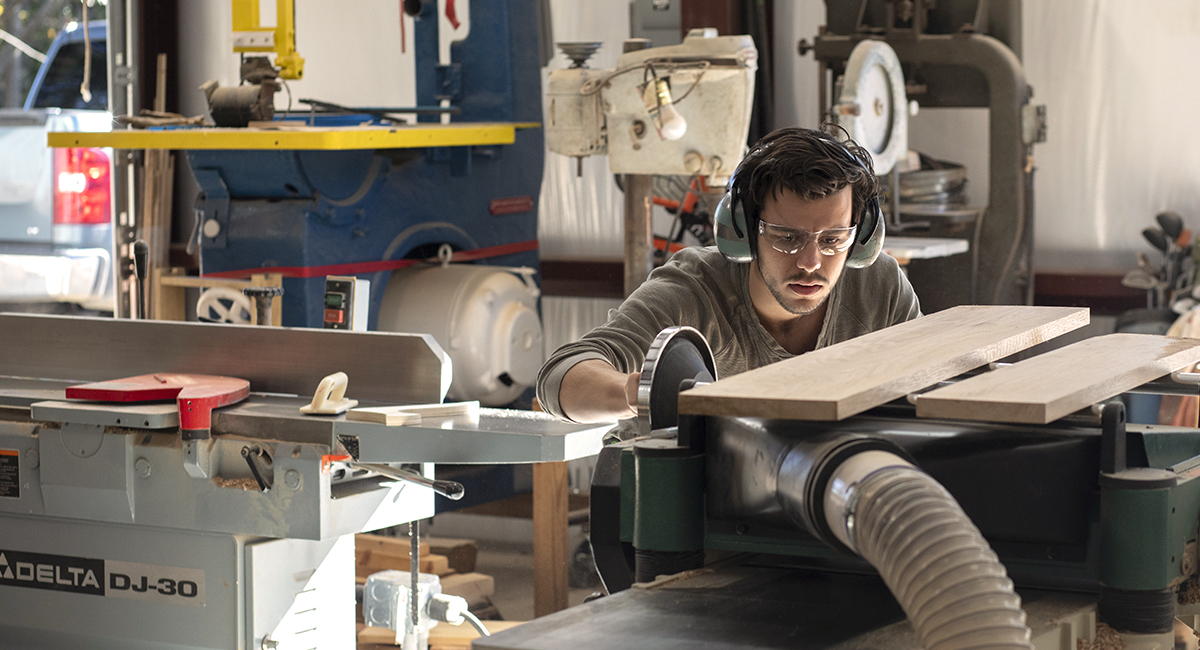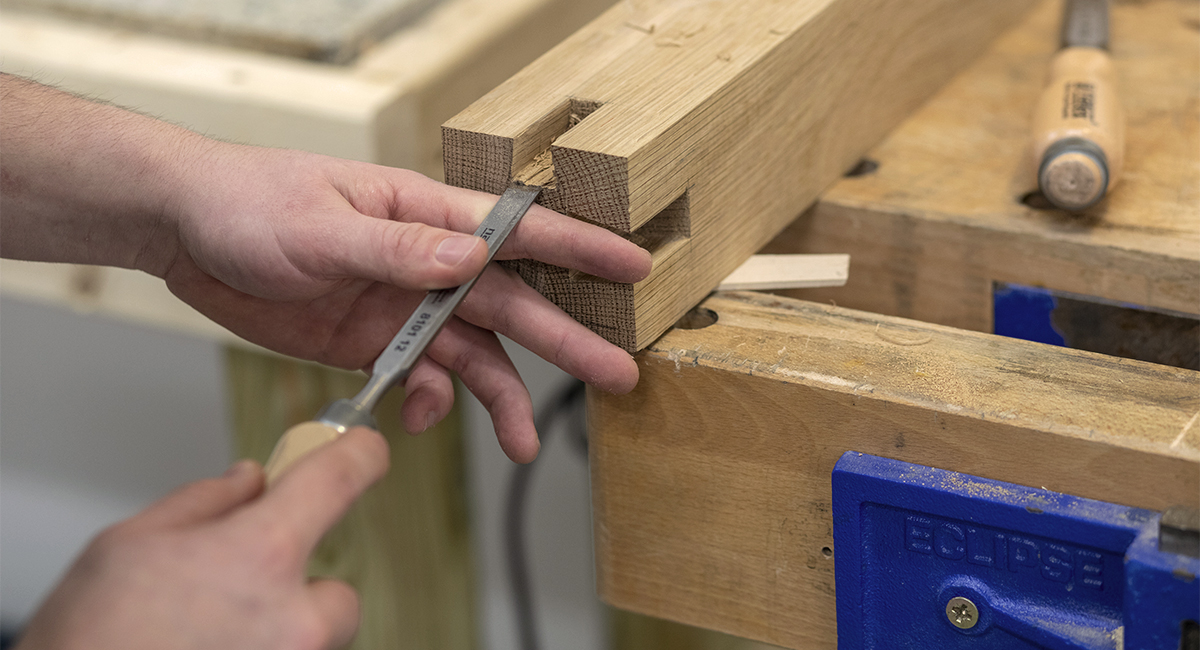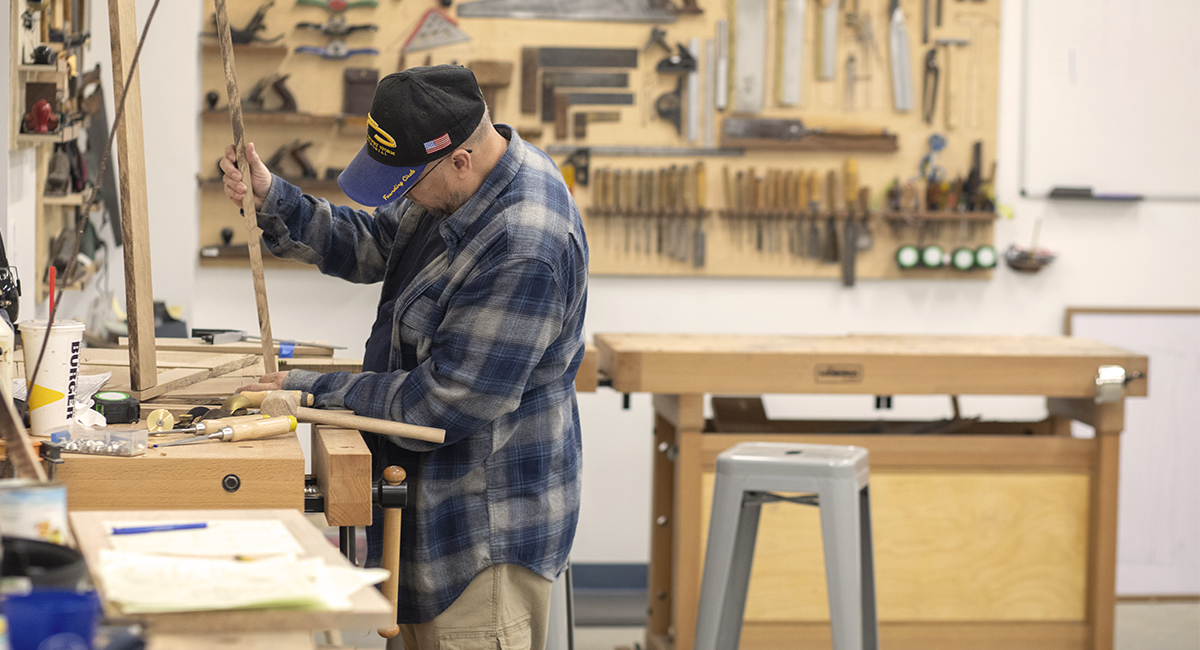The perfect desk job
With a broad education and a creative passion, Sam Sprouse crafts a career to his liking.
Posted on: February 4, 2019; Updated on: February 4, 2019
By Chris Horn, chorn@mailbox.sc.edu, 803-777-3687
Wielding a wooden mallet and a chisel as sharp as a scalpel, Sam Sprouse slices and chips at the end of an oak board, cutting the pins and tails of a classic dovetail joint. Whack, slice, whack, chip, whack, slice — you can tell he’s done this a thousand times.
It’s another day in class at the Charleston Woodworking School where Sprouse teaches his students the right way to make fine furniture, using traditional tools and a craftsman’s sensibility. To succeed here, the only school of its kind in the Palmetto State, students make lots of mistakes — and learn from each one.
“To make high-end furniture, you have to be a little OCD with a very high attention to detail,” Sprouse says. “But a lot of woodworking is not perfect at all. There’s always going to be a tiny gap or a knot or dip in the wood. All those imperfections are what makes the handmade aspect that much better.”
That could be a metaphor for Sprouse’s own imperfect career journey — a student of sociology who eventually became a professor of woodworking; an artisan whose broad education at Carolina and beyond enabled him to smooth over the knots and gaps and forge his own path.
But forget the woodworking metaphor for now — Sprouse’s education really started with a guy named Feaster Newton.

Sam Sprouse built a new building to accommodate enrollment at his Charleston Woodworking School — and he has plans for another expansion to accept as many as 22 students per year.
Half-lap joint
Sprouse helped his dad build fences and other rough carpentry projects as a boy, and he sometimes watched his grandfather repair furniture. But he took on a bigger task for his Eagle Scout project — building an outdoor chapel for the Church of the Good Shepherd in Asheboro, N.C.
“A gentleman at the church, Feaster Newton, was an experienced woodworker and one of my best friend’s grandfather. He was a great guy,” Sprouse says. “When he taught us how to make a half-lap joint, it piqued my interest — you can put wood together like that? That was kind of my introduction to traditional wood joinery.”
With those basic woodworking techniques tucked away, Sprouse followed in his father Walt’s footsteps to Carolina, starting out in biology. Too much late-night fun and too many 8 a.m. classes his freshman year derailed that major, but Sprouse found a sociology course fascinating, and it paired well with his religious studies minor. “I wanted to learn as much as I could about sociology. For a while, I even thought I wanted to become a professor,” he says.
He’d been working at a bank through college and continued in that field for a year after graduation. But when Sprouse and his wife, Anne Nicole, (’02 nursing) landed in Denver for her job, he wasn’t eager to sit in front of a computer screen again. He signed up for a woodworking course instead, and the smell of sawdust reawakened those earlier carpentry experiences. He found the website for the Chippendale International School of Furniture in Scotland and thought about enrolling.
“My wife was very patient and kind when I told her that I wanted to pursue a fulltime woodworking career,” he says. “She said, ‘Let’s do it,’ and we both headed off to Scotland.

Welcome aboard
Completing the Chippendale program was arduous, but Sprouse returned with refined skills in wood joinery, furniture making and design, and he immediately put them into practice at a dream job in Charleston.
Working for a company that renovated luxury yachts and sailboats, Sprouse was in charge of trim work, which meant cabinet building and custom moulding. “And as you know, on a boat there are no straight lines — everything had to be custom fit and shaped. It was such a challenge and so much fun!” he says.
Ultimately, the yacht restoration company didn’t survive the Great Recession, but Sprouse felt he had gained enough experience to launch his own custom furniture business.
“I found some great contacts and worked for quite a few interior designers building cabinets and tables all over the Southeast,” he says. “I have furniture all the way from Florida up to New York harbor, including a table on a converted tugboat.”
Unfortunately, Sprouse injured his back during the years of yacht restoration work — “I thought I was Superman, trying to lift a couch onto a moving boat” — and that led to two surgeries not long after. “I knew my back wouldn’t last for a solo woodworking career,” he says. He weighed the option of returning to a 9-to-5 job and becoming a woodworking hobbyist, but ultimately drew his line in the sawdust. “I couldn’t just stop being a woodworker. This is what I do.”

School’s in session
That’s when Sprouse launched the next iteration of his woodworking career as the sole proprietor of the Charleston Woodworking School. Initially he took only a couple of students, using a curriculum based roughly on his studies in Scotland. Word spread about the state’s only school for professional woodworkers, and Sprouse had to build a larger facility with capacity for 15 fulltime students. He’s already planning an expansion that would allow a total of 22.
“I don’t like speaking in front of people that much, but with woodworking it just comes naturally. Whenever I do demonstrations in the morning, I’ll set up a piece of work and just talk about what’s going through my mind,” he says.
“A lot of mistakes are made in our classes, but I’m a huge fan of mistakes because that’s how you learn. That’s kind of my teaching method — make the mistakes and then fix them. It’s better to make them here than when you’re on your own and working for a client.”
Sprouse brings in fellow wood artisans as guest lecturers such as world-renowned carver Mary May from Johns Island, wood turner Ashley Harwood from West Ashley, and a chair caning expert with 40 years of experience.
Students start out learning to sharpen their handtools, then spend several weeks learning traditional joints — the half lap, rule joints, knuckle joints and dovetails — before moving on to design basics, cost estimating, veneering, marquetry, gilding, chair caning, restoration and French polishing. Small Business Development Center staff give them a primer on starting their own firms. By the end of the year, students have several pieces of furniture they’ve designed and hand built to show off — even sell if they want to — at a graduation party.

Student speak
Most students who enroll at the Charleston Woodworking School are eager to become craftsmen and start their own businesses.
“Woodworking is tough for the first few years, but after your name is out there and people know the quality of your work, it can be very lucrative,” Sprouse says.
Many of his students have been military veterans, some of them with PTSD or other disabilities. “In my opinion [woodworking] seems to help them with their stress,” Sprouse says, “and that, along with passing along some valuable skills, means more to me than anything.”
Tony Lovett retired from the Army after 21 years without disabilities, but he did have VA education benefits and a passion for making 18th century reproduction furniture.
“I could not have been happier with the results,” says Lovett, who launched Charles Towne Woodworks not long after graduating in June 2018. “Sam does things traditionally and correctly — that’s the great thing about the school.”
Victoria DeMers had almost no woodworking experience before enrolling in the program the same year as Lovett. But Sprouse was impressed with her moxie. “I would rather take someone with a very basic knowledge of woodworking and teach them the right way to do it, as opposed to someone who’s been in woodworking for 10 years, and I show them the traditional way, the hard way, and they don’t want to pick it up.”
Inspired by the simplicity of Shaker furniture, DeMers is launching Straight Arrow Woodworks LLC in Mount Pleasant, S.C., and hopes the skills she picked up at the Charleston Woodworking School will help her make her own mark on the custom furniture scene.
“This is my calling,” she says. “Sam has a lot of knowledge and experience, and if you ask the questions, he can answer anything.”
Andrew Murray, a current student, started out at Appalachian State University in product design, then found out about Sprouse’s school.
“I’ve realized that I’m learning more here than people I know who are going to four-year furniture design programs,” Murray says. “It’s much more intense and in-depth here. I’m hoping this will really beef up my design portfolio.”
The overhead of operating a professional woodworking school is such that it will never be a lucrative venture, Sprouse says, but his broad education has taught him that career satisfaction can be its own reward. He opens a large door on the side of the school’s machine shop, revealing a scenic view of the Ashley River wetlands. “That’s what I call an office with a view,” he says, smiling. “I’d rather do this than make a ton of money sitting behind a computer all day.”